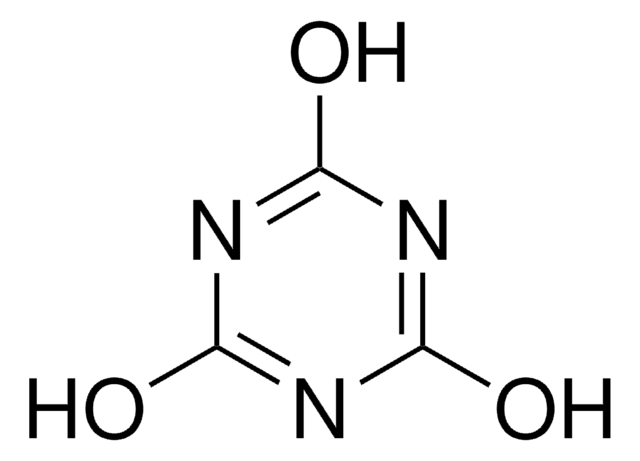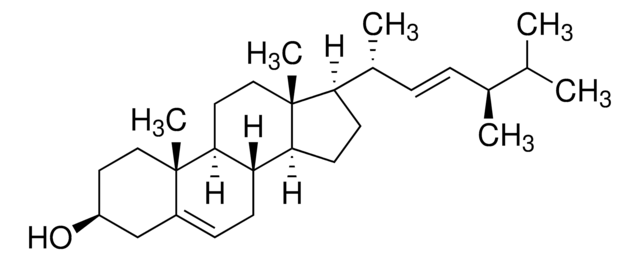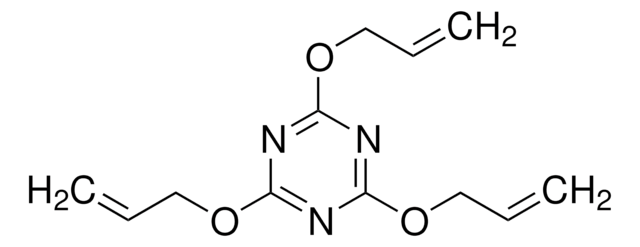All Photos(1)
About This Item
Empirical Formula (Hill Notation):
C3H3N3
CAS Number:
Molecular Weight:
81.08
Beilstein:
104790
EC Number:
MDL number:
UNSPSC Code:
12352100
PubChem Substance ID:
NACRES:
NA.22
Recommended Products
Assay
97%
mp
77-83 °C (dec.) (lit.)
SMILES string
c1ncncn1
InChI
1S/C3H3N3/c1-4-2-6-3-5-1/h1-3H
InChI key
JIHQDMXYYFUGFV-UHFFFAOYSA-N
Looking for similar products? Visit Product Comparison Guide
Related Categories
Signal Word
Danger
Hazard Statements
Precautionary Statements
Hazard Classifications
Acute Tox. 4 Oral - Eye Dam. 1 - Skin Irrit. 2 - STOT SE 3
Target Organs
Respiratory system
Storage Class Code
11 - Combustible Solids
WGK
WGK 3
Flash Point(F)
Not applicable
Flash Point(C)
Not applicable
Personal Protective Equipment
dust mask type N95 (US), Eyeshields, Gloves
Choose from one of the most recent versions:
Already Own This Product?
Find documentation for the products that you have recently purchased in the Document Library.
Customers Also Viewed
Shivraj Hariram Nile et al.
Food and chemical toxicology : an international journal published for the British Industrial Biological Research Association, 132, 110659-110659 (2019-07-06)
Subcritical water extraction (SWE) applied to analyses the bioactives from ashwagandha (W. somnifera) at varying temperature (100-200 °C) and extraction time (10-30 min). The effect of temperature and time has been investigated in terms of extraction yield (EY), total phenolic content (TPC)
Jerzy Drzewiecki et al.
Applied biochemistry and biotechnology (2018-05-10)
Electrophoretic, antioxidant, and FTIR profiles of some varieties of amaranth, quinoa, and buckwheat seeds and their by products were compared. Water extracts of these products were evaluated by the Folin-Ciocalteau method in order to determine total phenolic content. The antioxidant
Mengmeng Huang et al.
Scientific reports, 6, 32368-32368 (2016-09-03)
We used the support vector regression (SVR) approach to predict and unravel reduction/promotion effect of characteristic flavonoids on the acrylamide formation under a low-moisture Maillard reaction system. Results demonstrated the reduction/promotion effects by flavonoids at addition levels of 1-10000 μmol/L. The
Louis B Jugnia et al.
Environmental science and pollution research international, 25(20), 19436-19445 (2018-05-08)
Bioremediation was performed in situ at a former military range site to assess the performance of native bacteria in degrading hexahydro-1,3,5-trinitro-1,3,5-triazine (RDX) and 2,4-dinitrotoluene (2,4-DNT). The fate of these pollutants in soil and soil pore water was investigated as influenced
Qing-Ping Hu et al.
Scientific reports, 7, 45231-45231 (2017-03-25)
Cyperus rotundus L. (Cyperaceae) is a medicinal herb traditionally used to treat various clinical conditions at home. In this study, chemical composition of Cyperus rotundus rhizomes essential oil, and in vitro antioxidant, DNA damage protective and cytotoxic activities as well
Our team of scientists has experience in all areas of research including Life Science, Material Science, Chemical Synthesis, Chromatography, Analytical and many others.
Contact Technical Service








